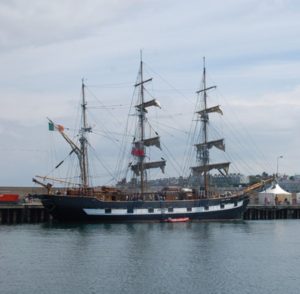
Although many Irish people emigrated from Ireland in order to escape suffering due to the famine, they faced a new set of challenges while immigrating. During the year 1847 especially, immigrants were crowded into disease-ridden ships, which have been referred to as ‘coffin ships’ because of the high death that tolls for passengers. Not only were the ships overcrowded, in many cases, they had been intended to hold lumber, rather than passengers. The ships were not designed for the comfort and safety of many passengers, and furthermore, many of them were not in good condition for sailing.
Diseases such as typhus and dysentery spread quickly on crowded ships. Many peasants were already ill when they boarded these ships, and the unsanitary conditions on the ships aided the spread of disease. In 1847, especially, the spread of typhus and dysentery on coffin ships reached levels that have been referred to as “epidemic.” The immigrants who died on board coffin ships were quickly buried at sea. Out of the 4,427 immigrants who traveled to Montreal in July of 1847, 804 died at sea and 847 were sick when they arrived in Montreal. Not to mention, illness threatened the supply of rations, as the sick tended to be thirsty, and rations could be further threatened if the conditions of a ship or the weather conditions caused a voyage to stretch on longer than intended. In other cases, passengers had been so desperate to leave Ireland and the famine behind that they didn’t prepare well enough for long voyages.
Robert Whyte, a passenger on one of the coffin ships, described the conditions on these ships in the diary he kept of the experience, saying in one entry, “A few convalescents appeared upon deck. The appearance of the poor creatures was miserable in the extreme. We now had fifty sick, being nearly one half of the whole number of passengers. Some entire families, being prostrated, were dependent on the charity of their neighbors… The brother of the two men who died on the sixth instant followed them today… The old sails being all used up, his remains were placed in two meal-sacks…” Whyte’s account highlights the hardships that passengers faced on coffin ships, as almost half of the ships’ passengers were sick, and so many had died that the old sails were used up burying people at sea.
However, Whyte’s diary simultaneously reveals the gaps in the typical narrative of the Irish immigrant experience. In one of his earliest entries, Whyte says that “On account of this discovery [of a stowaway], there was a general muster in the afternoon, affording me an opportunity of seeing all of the emigrants- and a more motley crowd I never beheld.” When people think of Irish immigration, they typically think of the Irish as a unified class of people, and Whyte’s account reveals that this was not the case, as Whyte clearly thinks of himself as separate from the rest of the immigrants. Earlier in his account, he notes that he has his own stateroom, which shows that he was of a higher economic class than most of the immigrants on the boat. Whyte’s account also shows that Irish famine immigrants were looked on with pity and disgust, even by their own countrymen, an aspect of Irish immigration that is often left out of the typical narrative.
On top of all the difficulties that immigrants faced on board coffin ships, they also had to contend with the looming threat of shipwreck. On one voyage in May of 1847, for example, a ship called the Carricks was wrecked off of the coast of Quebec. Only a quarter of the passengers were able to swim to shore and survive.
Even once they reached their destinations, immigrants weren’t guaranteed an easy life. CLICK HERE to learn more about the challenges that immigrants faced upon reaching North America. CLICK HERE to learn about living conditions for Irish immigrants.

The immigrant experience still looms large in the public mind. The National Famine Monument in County Mayo, Ireland, depicts a coffin ship surrounded by skeletal figures. The monument was created in 1997 by sculptor John Behan, and is dedicated to all those who lost their lives during the Great Famine, although it specifically invokes Irish experiences on coffin ships. By commemorating the coffin ships in the way it does, the Mayo monument reaffirms the typical, simplistic narrative of Irish immigration history. Since it is the National Famine Monument, it implies that coffin ship experiences were emblematic of the entire Irish immigrant experience, or even the entire Irish famine experience. It’s especially important to consider the disconnect between the emotions the memorial invokes and the reality of the situation, considering that the worst of the coffin ship experiences were mostly confined to 1847; the coffin ship experience by no means encompassed the entirety of the Irish immigrant experience.
CLICK HERE to learn more about other monuments to the famine.
CLICK HERE to return to the main page.
